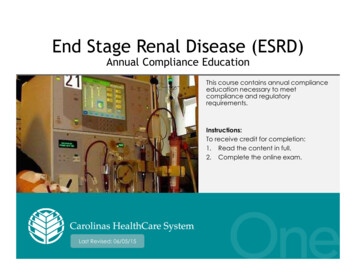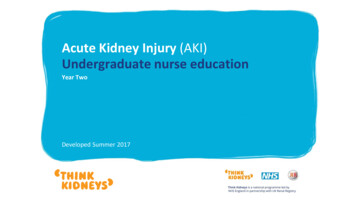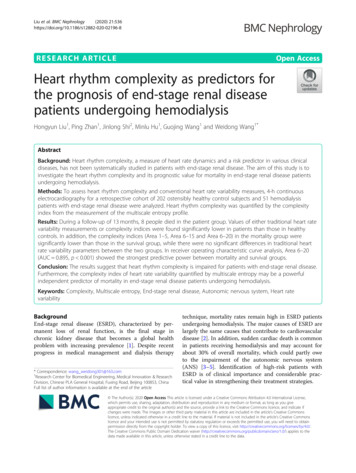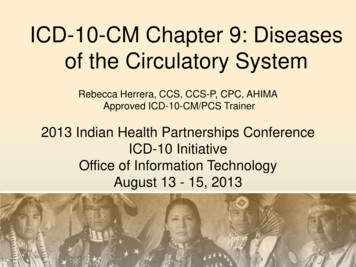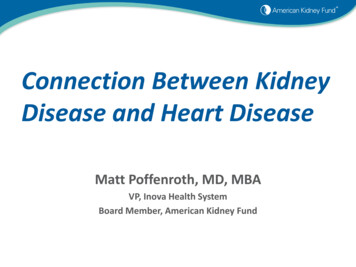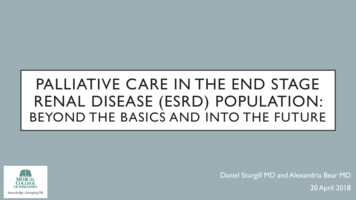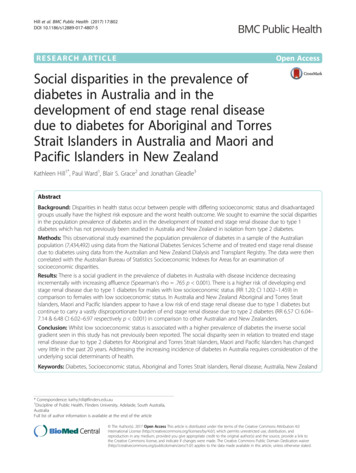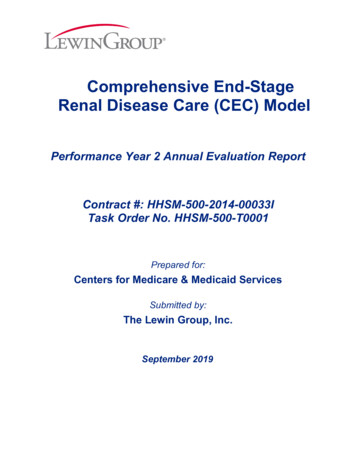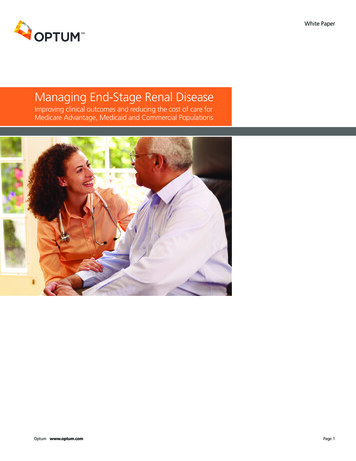
Transcription
White PaperManaging End-Stage Renal DiseaseImproving clinical outcomes and reducing the cost of care forMedicare Advantage, Medicaid and Commercial PopulationsOptum www.optum.comPage 1
Managing End-Stage Renal DiseaseExecutive SummaryThe end-stage renal disease (ESRD) management program delivered by OptumTMKidney Resource Services (KRS) reduces health plan costs by facilitating clinical excellenceand providing complex case management services. An impact analysis of the KRS ESRDdisease management program implemented for a national Medicare Advantage planfound a 24.8 percent reduction in inpatient admissions, a 10.3 percent reduction inER visits and an 8.5 percent reduction in specialty visits. In 2012, the program achievedover 16 million in total cost reduction and a 3.7:1 return on program investment.Kidney Resource Services provides disease management programs focused on mid tolate stage renal disease to health plans, employer groups, reinsurers and third partyadministrators. This white paper describes how such programs can improve the qualityof care and reduce overall costs for Medicare Advantage, Medicaid and commercialpopulations. Topics covered include: An overview of end-stage renal disease and its impacts Challenges and trends in patient care How KRS programs improve clinical outcomes and reduce costs A summary of ESRD program resultsBackgroundEnd-stage renal disease is an irreversible decline in kidney function requiring ongoingdialysis or kidney transplantation to sustain life. The human impacts of ESRD are severe,and the aggregate costs of ongoing dialysis, recurrent hospitalizations and treatment ofco-morbid conditions can overwhelm both patients and their health plans. In 2011, totalMedicare costs for ESRD were 34.3 billion, fully 6.3 percent of the agency’s budget.1Medicare costs per person per year (PPPY) for hemodialysis patients were 87,945,compared to 32,992 for post transplant kidney recipients.1 Not considering the costof prescription drugs, PPPY costs in the commercial dialysis population are over 2 timesgreater than the Medicare dialysis population.1Not only is the human toll of ESRD severe, the number of individuals living with thisdiagnosis continues to rise (see figure 1). As of December 31, 2011, 615,899 individualshad a diagnosis of ESRD. The rate of prevalent ESRD cases reached 1,901 per million,which is 26 percent higher than the rate in rimaryDiagnosisPrevalent counts of ESRD, by Primary Diagnosis2500- ‐1920- ‐4445- ‐6465- ‐7475 )Number11PrevalentcountsofESRD,by 8790939699Year02050811USRDS 2013 Annual Data Report, Vol. 2. Figures 1.12 & 1.15Figure 1. Prevalent Counts of ESRD by Age and Primary CauseOptum www.optum.comPage 2
Managing End-Stage Renal DiseaseThe importance of managing chronic kidney disease (CKD) prior to end-stage kidneyfailure, as well as managing ESRD are illustrated by figure 2. The chronic diseasesof diabetes, congestive heart failure (CHF) and CKD are associated with the highestpopulation-level expenditures in fee for service (FFS) Medicare. Patients with recognizedCKD, who represent 12.7 percent of the point prevalent population, account for28.9 percent of total expenditures. ESRD patients account for another 7.2 percent ofMedicare FFS expenditures. The combined CKD and ESRD populations are associatedwith 36.1 percent of the Medical FFS costs, comparable to that associated with ral Medicare:2011(n 31,699,027;meanageage69.1)69.1)(n 1General Medicare:( 355billion)( 355 billion)CKD 28.9%CKD 12.7%DM 27.5%CHF 13.2%DM 43.8%CHF 36.5%ESRD 1.4%ESRD 7.2%None 61.2%None 34.0%USRDS 2013 Annual Data Report, Vol. 2. Figure P.I.USRDS 2013 Annual Data Report, Vol. 2. Figure P.I.Figure 2. “Distribution of general (fee-for-services) Medicare patients & costs for CKD,Figure2. “Distributionof general (fee-for-service) Medicare patients & costs for CKD,CHF,Diabetes& ESRD, 2011.CHF, diabetes, & ESRD, 2011.Challenges and Trends in ESRD CareAlthough substantial strides have been made in dialysis therapy, individuals with ESRDface significant challenges. The first months of dialysis are characterized by a combinationof high mortality rates and high costs associated with the initiation of dialysis, whichoften occurs in an inpatient setting.3,4 The survival rate of hemodialysis patients threeyears after the start of therapy is only 52 percent. In contrast, the three year survival ratefor individuals that receive a kidney transplant is 92 percent.4As individuals continue on dialysis, they are likely to experience ongoing complicationsresulting in hospitalizations. Risk factors associated with increased morbidity includecardiovascular disease, hypertension, diabetes, infection, bone disease, anemia, andmalnutrition. On average, hemodialysis patients experience 1.84admissionsyear, Do not distribute or reproduce without express permission from Optum.Confidentialpropertyperof Optum.11.7 inpatient days and a 36 percent readmission rate.5 End-stage renal disease patientstypically experience multiple comorbidities and take between 11 and 13 medications.As a result, these individuals require specific management plans and complex carecoordination across multiple clinical specialties.Optum www.optum.comPage 31
Managing End-Stage Renal DiseaseKidney Resource Services Disease Management ProgramWithin Optum Kidney Resources Services, disease management is conceived as a systemof coordinated health care interventions and communications to both members andproviders to ensure that kidney disease patients receive proper care, and to support themthrough the challenges of self care. Our disease management program: Supports the provider-patient relationship and plan of care; Consistently applies evidence-based care standards and patient empowermentstrategies to reduce or prevent complications and exacerbations Continually evaluates clinical, human, and economic outcomes to improve overall health.The KRS disease management program identifies at-risk plan members using proprietarytechnologies to risk-stratify program-eligible individuals through claims and laboratoryinformation. The program engages members directly to encourage enrollment, thenprovides each enrolled member with ongoing disease management services and planmanagers with comprehensive reporting on interventions and management activities.Member interactions are conducted by registered nurse advocates with specializedtraining in renal disease treatment, whose experience and knowledge delivers a successrate of more than 80 percent in enrolling at-risk members. Peer to peer case reviewsare also provided by the program medical director for a subset of cases.Targeted Program InterventionsKidney Resource Services disease management program interventions are focused onthe specific issues facing mid to late stage kidney disease patients and address the majordrivers of hospitalization and dialysis costs. More than 100 interventions have been developedunder the direction of the program’s medical director—an ABIM certified nephrologist—using evidence based guidelines from the National Kidney Foundation Disease OutcomesQuality Initiative. Kidney Resource Services nurse advocates provide disease stage specific,complex condition management that combines patient education, dialysis monitoring,and management of comorbidities related to renal failure. This integrated approach todisease management is a critical factor in the program’s unique effectiveness.The following examples of KRS ESRD program interventions illustrate the breadth anddepth of this integrated methodology.Patient and Caretaker Education and Empowerment Dialysis patients must adhere to a complex regimen of diet and fluid restrictions,medication, and dialysis therapy. The KRS training and quality review programfocuses our nurse advocates on helping patients make positive choices and achieveself-management behavior, which has been shown to be important in achievingpositive health outcomes.6 Patients and caregivers are provided with educationto develop the necessary knowledge and skills – and KRS nurses encourage theinclusion of valued peers to provide reinforcement and support.Reducing Complications through Co-morbidity Management Cardiovascular disease is a predominant cause of death in dialysis patients.7KRS nurse advocates identify opportunities to apply evidence-based therapiesincluding cardiovascular screening, control of blood pressure and medicationmanagement. The program nurse advocate works proactively with patients andproviders to implement interventions that effectively reduce this risk. Diabetes puts ESRD patients at heightened risk for stroke, vision loss, abnormallipid profiles, cardiovascular disease and complications that may lead to infection.Proper foot care is required due to nerve and blood vessel damage, where infectionmay lead to amputation. Vision and mobility loss are significant negative impacts toquality of life. Between 2010-2011, only 14.4 percent of all diabetic ESRD patientsreceived comprehensive care that included glycemic control monitoring, lipidmonitoring and eye examinations.5 Opportunities to improve care of diabetic ESRDpatients are a key focus of the KRS disease management.Optum www.optum.comPage 4
Managing End-Stage Renal DiseaseComprehensive Dialysis Access Management Dialysis access management includes optimal access placement and preservationfor each patient. For hemodialysis patients, the ateriovenous fistula (AVF) offers thelowest complication rate and associated costs, followed by the ateriovenous graft(AVG) and lastly the catheter.8 Upon enrollment in the KRS disease managementprogram, patients are provided with access maintenance education. In particular,patients with existing catheter access are prioritized for alternative access educationand referred for assessment for AVF or AVG placement.Kidney Transplantation Evaluation Time spent on dialysis is significant predictor of transplant outcomes, as graft andpatient survival declines with each year of therapy.9 In 2010, only 16.9 percent ofdialysis patients under age 70 were either wait-listed for transplantation or receiveda donor kidney within one year of beginning therapy. For patients aged 45-64 therate was 15.8 percent, and just 11 percent for those aged 65-70.10 However, withgrowth of the aging population and improvements in medicine and transplantation,the demand for and feasibility of transplantation for individuals age 65 is increasing.Mortality rates and treatment costs are significantly lower for ESRD patients whoreceive timely transplants than for those who remain on long-term hemodialysis.Transplantation education, early referral for evaluation, and assistance in maintainingtransplant readiness are primary objectives of the KRS ESRD program.Additional Considerations for Medicare PopulationsMedicare populations typically present higher risks than commercial plan membershipsdue to their relatively advanced age, increased co-morbidities, changes in cognition andmemory, reduced resources (personal and financial), and limitations in transportationaccess and self-care capabilities. The KRS disease management program has implementedadditional strategies to reduce these risks, including: Focusing on the most important 1-2 issues for each patientEncouraging and proactively seeking caretaker involvementScreening for and addressing depressionAdjusting medication regimes for dialysis and identifying lower-tier alternativesFacilitating timely transplant referral and expediting the evaluation processEncouraging end-of-life health care planning to ensure that patients considerand articulate their treatment preferencesCaregiver SupportEngagement with caregivers,identification of and referral tocaregiver support resourcesAdmission PreventionFocus on key drivers of admissions,facilitate post discharge plan of care,prevent re-admissionsCommunity ResourcesCoordination of local transport,meal delivery, home health servicesand benefitsCondition MonitoringPatient education, co-morbid conditionand medication managementDialysis TherapyCoordination of care plan withnephrologist, dialysis nurse, socialworker and nutritionistTransplantationEducation and referral, facilitateprogression through evaluation andlisting, maintain transplant readinessCoordination with MedicalSpecialtiesEndocrinology, podiatry, ophthalmology,cardiology, pharmacyBehavioral HealthDepression assessment and referral forbehavioral health supportDedicated renal-trained registered nurse supported by guidance from our ABIM certified nephrologist Medical Director.Identification and resolution of patient educational needs/gaps in care via risk-based patient/provider outreach.Intervention based on National Kidney Foundation Disease Outcomes Quality Initiative. NCQA and URAQ accredited.Optum www.optum.comPage 5
Managing End-Stage Renal DiseaseDemonstrating Kidney Disease Management ValueProgram review and reporting is an essential capability for providing health planswith detailed information on disease management activities and their impacts onmember health, clinical outcomes and treatment costs. Key reporting metrics forthe KRS program include: Member referral and program enrollment ratesInitiation and resolution of key interventionsClinical parameter review, including trending key laboratory values monitoredfor kidney patients as well as assessments of therapy adequacyUtilization of contracted dialysis providers, where appropriateKey utilization metrics, including inpatient admissions, readmissions andemergency room treatments, andCost savings reports, including pre-post program implementation analysisAnalyzing the value delivered by the Optum kidney disease management program forMedicare Advantage populations illustrate the opportunities that are available to healthplans to improve member health and reduce treatment costs in a population that typically: Carries a greater burden of co-morbidities, related risks, and higher utilizationsIs less open to, or less suitable for, cost reduction through transplantationIs eligible for dialysis reimbursement at Medicare levels, which may preclude useof the KRS network of contracted facilities to drive cost savings.In 2012 and 2013, Optum, in conjunction with external healthcare economics resources,completed a multi-year analysis of ESRD program savings for a Medicare Advantagepopulation of approximately 1.1 million members not previously covered by a specializedESRD disease management program. The analysis was population-based and not exclusiveto members participating in the program.Among the notable program achievements were a 24.8 percent reduction in inpatientadmissions, a 10.3 percent reduction in ER visits and an 8.5 percent reduction in specialtyvisits. In 2012, the program achieved over 16 million in total cost reduction and a 3.7:1return on program investment. The greatest component of the savings was attributable toreductions in inpatient costs.11Optum also reviewed program performance in a subset of the Medicare Advantagepopulation, the dually eligible special needs plan (D-SNP) membership. About 9 million ofMedicare’s over 48 million beneficiaries are also eligible for Medicaid because they meetincome and other criteria.12 These dual-eligible beneficiaries have greater health carechallenges than other Medicare beneficiaries, increasing their need for care coordinationacross the two programs. In reviewing program performance for ESRD member’s enrolledin Medicare Advantage D-SNP plans, results showed a 25% reduction in inpatientOptumHealth ESRDMWhiteprogramPaper — RevisedJanuary 16, 2014admissionsfrom theimplementationyear of 2009 as compared to the secondfull year of implementation in 2011.137.Dual SNP- ESRDTwo factors were critical in each of these accomplishments: strong member ggapsaccomplishments:in patient care. strong member enrollment in thewerein significanteach of theseprogram, and closing significant gaps in patient care.Optum www.optum.comProgram Engagement ResultsPage 6
Managing End-Stage Renal DiseaseProgram Engagement ResultsBecause ESRD members are an inherently high-cost, low-prevalence population, a highrate of at-risk member enrollment is a precondition of program effectiveness. In a MedicareAdvantage population Optum experiences an ESRD program engagement rate of 80percent.13 While high, this rate is also consistent with reported enrollment rates forcommercial populations.Gaps in Care AddressedA KRS program intervention is initiated when a nurse advocate identifies a gap in care.An intervention is considered complete when a change in treatment or behavior, facilitatedthrough communication with the patient and/or provider, has closed that gap. Completionof interventions represents the success of the KRS program in addressing issues facingindividuals with ESRD and is the method by which the program improves outcomes,0 - August 2011prevents complications and reduces costs.20102183.9Top10CompletedESRDProgramInterven ons4504003503002502001501005003881Over a twelve month period, the Medicare Advantage population reviewed recorded nearly2000 gaps in care that were identified and resolved by KRS nurse advocates, representing thetop ten gaps identified. During this period, nearly 3,900 unique individuals were enrolledin this plan’s ESRD management program.13The number of opportunities confirmed by the KRS program indicates to health planmanagers that gaps in care do exist. The gaps identified and resolved were closely alignedwith high-level KRS program goals and with issues important to Medicare Advantagepopulations. Gaps included completion of advanced directives, immunizations, timelyreferrals for transplant, and depression assessment and 1002050Optum www.optum.com200820092010Page 7
Managing End-Stage Renal DiseaseConclusionESRD is a complex condition that confronts patients with formidable medical issues andchallenges the financial performance of their health plans. Substantial coordination of careis required to achieve the best possible outcomes for these individuals, and many gapsin care exist. End-stage renal disease management programs provide condition-specificinterventions and clinical support through a staff of patient advocates who are specificallytrained in this complex condition. By identifying and resolving gaps in patient care, ESRDdisease management programs reduce risks and costs while improving individual healthoutcomes.Optum Kidney Resource Services has provided renal disease management servicessince 2006. We support health plans, employer groups, reinsurers and third partyadministrators with more than 20 million insured lives and provide disease managementservice to over 10,000 members with Mid-to-Late Stage CKD or ESRD. Our programdelivers documented value for Medicare Advantage and commercial populations,including significant reductions in inpatient utilization and a return on programinvestment of 3:1 or better.About the AuthorTracy Sanders, M.Ed. Tracy Sanders is a director of product for Optum Care Solutions,Complex Medical Conditions. She is responsible for managing the Kidney ResourcesServices programs offered to organizations supporting Medicare and Medicaid members.Prior to joining Optum, she has held positions such as senior research and developmentproject manager, director of infrastructure and operations and renal therapy services globalinformation systems manager for Baxter International Inc. as well as serving as aninstructor for the Rush University Medical Center masters program in health administration.About OptumOptum is an information and technology company with a single mission: To help makethe health system work better for everyone. We’re a global team of 35,000 people,working together to modernize, strengthen and improve the health system by servingthose who need care, provide care, innovate for care and pay for care. For moreinformation about Optum and its products and services, please visit www.optum.com.Contact UsOptum11000 Optum CircleEden Prairie, MN 55344T 1 (866) 427-6845Contact Optum emailwww.optum.comOptum www.optum.comPage 8
Managing End-Stage Renal DiseaseReferences1. U.S. Renal Data System, USRDS 2013 Annual Report: Atlas of Chronic Kidney Disease andEnd-Stage Renal Disease in the United States. National Institutes of Health, National Institute ofDiabetes and Digestive and Kidney Diseases, Bethesda, MD, 2011, Volume 2, pages 326-328.2. USRDS 2013 Annual Report. Volume 2, pages 216 & 222.3. USRDS 2013 Annual Report. Volume 1, page 116-117.4. USRDS 2013 Annual Report. Volume 2, pages 264-267.5. USRDS 2013 Annual Report. Volume 2, pages 234, 238 & 246.6. Schatell, Dori and Paula Stec Alt. How understanding motivation can improve dialysis practices.Nephrology News & Issues, September 2008, pp. 32-36.7. American Journal of Kidney Diseases, Vol 45, No 4, Suppl 3 (April), 2005: pp S8-S9.8. Overview of Hemodialysis Complications accessed January 2, 2012 plications/tabid/606/Default.aspx9. Meier-Kriesche HU, Kaplan B. Waiting time on dialysis as the strongest modifiable risk factor for renaltransplant outcomes: a paired donor kidney analysis. Transplantation. 2002 Nov 27; 74(10):1377-81.10. USRDS 2013 Annual Report. Volume 2, page 206.11. External Healthcare Economics Analysis, 2012.12. http://www.gao.gov/products/GAO-12-864 accessed January 15, 2014.13. Optum Analysis, 2011-2012.T 866.427.6845 www.optum.com11000 Optum Circle, Eden Prairie, MN 55344All Optum trademarks and logos are owned by Optum, Inc. All other brand or product names aretrademarks or registered marks of their respective owners. Because we are continuously improvingour products and services, Optum reserves the right to change specifications without prior notice.Optum is an equal opportunity employer.DWD 3/14 2014 Optum, Inc. All Rights Reserved.
Managing End-Stage Renal Disease The importance of managing chronic kidney disease (CKD) prior to end-stage kidney failure, as well as managing ESRD are illustrated by figure 2. The chronic diseases of diabetes, congestive heart failure (CHF) and CKD are associated with the highest population-level expenditures in fee for service (FFS) Medicare.
